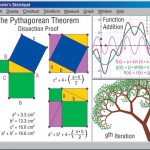Geometer’s Sketchpad (a Dynamic Geometry Software) is available to download for a twenty-minute test period or to purchase for a fee.
This software can be used to create an active learning environment in which students can learn various math concepts involving geometry and algebra.
Dynamic Geometry Software (DGS) employs visualizations (images) to create an environment that “foster(s) engagement with a mathematical concept that is often explained superficially” in a traditional classroom (Knuth & Hartmann, 2005 p. 163). Knuth et al. (2005) describe this engagement as a “conceptual conversation” which allows for a deeper understanding of mathematical ideas. DGS allows for more frequent and thoughtful manipulations of the equations and graphs than the former paper and pencil methods. DGS also allows for multiple ways to view math concepts, for example geometrical shapes, charts, and graphs. In addition, the images created using the technology are more complex and detailed giving the student a better sense of how the numbers truly affect change in the image.
Laborde (2000) and Hadas et al. (2000) each support the claim that the constructive nature of DGS helps students to find the correct answer and then to verify its accuracy. Hadas et al. (2000) argue for the importance of students being able to engage in “true mathematical activity” which they describe as the ability to construct and evaluate proofs (p. 149). Geometer’s Sketchpad allows students to do just that. Students can use the tools available through the software to explore, practice, and create relatively easily and quickly. Attempts can be changed or altered at the click of a mouse or the input of new data.
We must be aware that the role of the teacher and the design of the activity are still very important when using DGS. Geometer’s Sketchpad does offer professional development at a price as well as a FREE online forum (Sketch Exchange) where educators can share their ideas.
References
Hadas, N., Schwarz, B., & Hershkowitz, R. (2000). The role of contradiction and uncertainty in promoting the need to prove in dynamic geometry environments. Educational Studies in Mathematics,44 (1-2), 127-150.
Knuth, E. J. & Hartmann, C.E. (2005). Using technology to foster students’ mathematical understandings and intuitions. In Masalaski, W.J, & Elliott, P.C. (Eds.). (2005). Technology-supported mathematics learning environments, (pp. 151-165). Reston, VA: National Council of Teachers of Mathematics.
Laborde, C. (2000). Dynamic geometry environments as a source of rich learning contexts for the complex activity of proving. Educational Studies in Mathematics, 44 (1-2), 151-61

